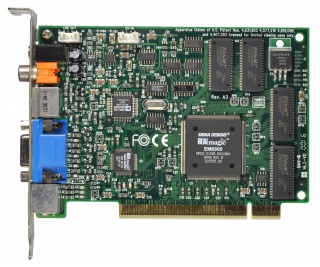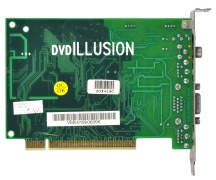DVD Illusion
| Bus type | PCI |
|---|---|
| Bus width | 32-bit |
| Bus speed | 33 MHz |
| PCI 5V tolerant? | Yes |
| PCI 3.3V tolerant? | Using "Is PCI 3.3V tolerant" as property chain is not permitted during the annotation process. |
| Manufacturer | Unknown |
| Chipset | EM8300 |
| Compatible with | DXR3 |
| Connectors | VGA, SPDIF/RCA, S-Video |
| Requires -5VDC? | No |
| Requires -12VDC? | No |
| Video Output | |
| Max memory | 2 MB 2,097,152 B |
| Max resolution | 1600 × 1200 |
| ROM type | None |
| Codec | |
| Max video resolution | 720 × 576 |
| Encode? | None |
| Decode? | MPEG-1, MPEG-2, AC-3 |
| Driver | Missing download URL |
The DVD Illusion is a variant of the Sigma Designs Hollywood+ MPEG decoder card. Designed to provide full decoding of DVD format video on systems too slow to do so in hardware, it was produced at a time when most consumer video cards did not have TV output, so its composite and S-Video output capabilities meant that DVDs could be viewed on conventional TVs. This alleviated the need to watch movies in front of the (typically much smaller) computer screen, as well as allowing Dolby Digital audio to be passed through to an external decoder.
Such was the novelty of this at the time, a number of media playback programs (especially in the Linux world) supported writing to the device's framebuffer directly. This allowed playback on a TV of non-MPEG video formats that the card could not decode in hardware.
Unfortunately the card's decoder was limited to DVD's maximum resolution of 720x576, which meant that when high-definition TV came out, it was not possible to use the card to decode 1920x1080 material.
The card worked by passing the system's existing VGA output through an overlay processor, which used chroma keying to replace a specific colour with a pixel from the MPEG framebuffer. This allowed both full-screen and windowed playback, and allowed the mouse cursor to be visible on top of the MPEG video for navigating DVD menus. Unfortunately as with any passthrough interface, the quality of the video signal noticeably degrades once passed through the decoder card, a drawback which is especially noticeable at higher screen resolutions. This typically manifested itself as a slight blurring of the screen content.
The overlay processor appears to have been operating close to its limit, as moving the mouse cursor over the video playback area would show artefacts around the edges of the cursor, due to the card having to rapidly switch between the incoming VGA signal and the MPEG framebuffer on a pixel-by-pixel basis. Nevertheless, this rarely impacted on playback or usability.
The output of the card was generally excellent, and noticeably smoother than equivalent software decoding. Even later video cards with TV output and software decoding still were unable to reach the video quality of the EM8300.
A number of "hacks" were produced around this card, including the ability to disable MacroVision and allow recording of DVDs onto VHS video tape. It was also possible to enable RGB output on the card, which when combined with a home-made adapter, could allow an analogue RGB signal to be fed to a TV. This was generally the highest quality connection available at the time, which provided an even better picture than the then-standard S-Video.
Additional photos
Notes
- The Creative Labs DXR3 was one of the first cards to use the Hollywood+ EM8300 chipset, so support for this device is often labelled as DXR3, whether the card is actually a DXR3 or not.

